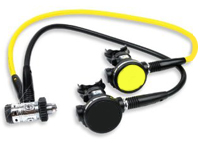Diving regulator

A scuba diving regulator enables the diver to safely breathe the air from his tank. It reduces the pressure of the air in the tank to the ambient water pressure and supplies it to the mouthpiece on demand (only while inhaling). The exhaled air is directed into the water by an exhaust valve under the mouthpiece.
Most regulators, used for recreational diving consist of two parts, the first stage and the second stage. The first stage reduces the high pressure, coming from the tank to an intermediate pressure. The second stage reduces the intermediate pressure to the ambient pressure. On top of that the 1. stage has additional connection opportunities for hoses to the Octopus (alternate air source), BCD and the pressure gauge.
The octopus is an additional 2.stage. It is required as alternate air source in case of problems with the primary device or for sharing the air with a dive buddy if necessary. It usually comes in a bright yellow color and with a long low pressure hose. The octopus should be attached somewhere in front of the rib cage and easy to reach in case of emergency.
Regulators are offered in a wide range of models with different features. An important point to consider is the breathing characteristic, they should be easy to breathe in any depth.
Not every regulator is suitable for every dive, for example, diving in cold water requires regulators with special preconditions. To choose the right regulator for your personal needs it’s a good idea to ask the local dive shop or instructor for advice before purchasing.
To get advice ask the instructors, or share your opinions with other divers in the diving equipment forum.
Look at the diving center directory to find a dive shop or diving center in your region.
All information and opinions provided are general and no substitute for professional advice. Always check with your diving instructor what fits best to your personal needs and to your level of training.











